How a Vapor Barrier Can Help Mitigate Radon in New Residential Construction
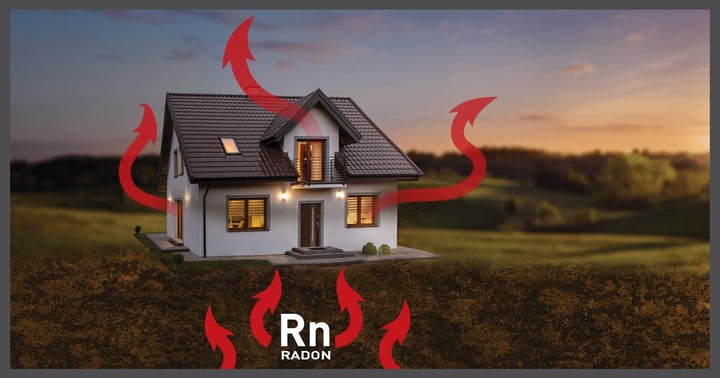
A colleague told me a story recently about a family of five who, in the midst of selling their house after living in it for seven years, found out their home had high levels of radon.
The parents — who had both been smokers for years — didn’t have a radon risk on their radar at all, but a radon test during a routine buyer inspection came back at 8.6 pCi/L, more than double the federal action limit. Doing some research, the mother found that at that high level, smokers are eight times more likely to get lung cancer from radon gas exposure than non-smokers, so she was understandably concerned. Even more, the parents were worried about their three children, who had been exposed to the gas for most of their lives.
As is the case with too many homeowners, the family didn’t do their own inspection or testing when they bought the home. There was no radon mitigation system in the house, nor any vapor barrier beneath the home to offer protection from soil vapor.
To prevent unfortunate stories like these, we as professionals in the construction industry have a responsibility to protect homeowners who don’t do their due diligence, and from the start — it’s our job to design and construct homes to protect the occupants from radon. Fortunately, the industry has basic guidelines and codes to make that happen.
This family’s story got me thinking of some of the considerations that homebuilders, architects, and contractors should know about radon, and which solutions provide maximum protection against unsafe levels of radon in homes. Besides protecting homeowners, taking preventive measures like these makes good business sense, too. Getting it right with proactive measures in the initial design and construction phase can be more cost effective than adding a radon mitigation system after the fact, and it ultimately means a happier, healthier client.
How Radon Enters the Home and Why It’s Important to Know
Radon gas most commonly comes from soil underneath your home’s foundation (while water can also be a source of radon gas in the home, it’s not as common, and the health risks are not as great). The colorless, odorless, radioactive gas can enter a house through entry points in the concrete floor slab (both basements and slabs-on-grade). In addition, radon can enter the home anywhere that’s exposed to outdoor elements — a vented crawl space with a dirt floor and no vapor barrier is often an easy entry point.
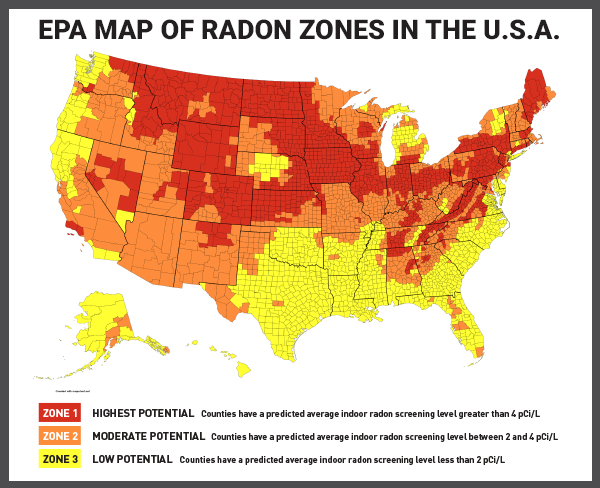
Image Source: US EPA
The concentration of radon in residential construction also depends on geography and location. In the case of the family who lived in a contaminated home for seven years, they didn’t realize their house in northeastern Pennsylvania was located in a hotspot on the EPA’s radon zone map. According to this map, the United States is split into three zones of varying risks for radon:
- Zone 1 (Red) signifies the highest risk of radon levels, above the US federal action limit of 4 pCi/L. This is found mostly throughout the northern and eastern United States.
- Zone 2 (Orange) signals a moderate risk of 2 - 4 pCi/L and is found mostly in the western United States.
- Zone 3 (Yellow), concentrated in the South, signifies a low risk of 2 pCi/L or lower.
It’s important to note that while the federal action limit for radon is 4 pCi/L (anything above that number is considered a high risk by the EPA and requires immediate mitigation), even lower concentrations of radon can still be harmful — any concentration of radon in a home is something to be concerned about.
Why is this so important? Because radon is the number one cause of lung cancer among nonsmokers, and if you’re a smoker exposed to radon, your risk is even higher. Even more, people exposed to radon are more susceptible to the effects of ionizing radiation and some natural sources of radiation, which can cause damage to skin and body organs, according to the World Health Organization.
Controlling Radon Gas in Design and Construction
Luckily, radon is a well-researched contaminant and already has many proven construction and mitigation techniques in the U.S. and around the world. So, unlike a lot of household contaminants, we have the tools to design and construct homes to keep families safe from radon exposure.
The best way to mitigate radon is to install a radon control system, particularly one that implements Active Soil Depressurization (ASD). A well-designed ASD system consists of a soil gas collector, a vapor barrier (also commonly referred to as a “soil-gas retarder”), piping, and a specially designed radon fan to depressurize the soil beneath the slab or under the soil-gas retarder in a crawl space. The result is a system that effectively stops, collects, and exhausts radon gas safely outside the home.
This system is most cost effective when installed during the construction process and can be implemented regardless of the homes foundation type (crawlspace, basement, or slab on grade).
For a new home, a high-performance, properly installed below-slab vapor barrier is a critical component of an effectively designed passive or active radon mitigation system – as the first (or sometimes, like in a crawl space, the primary) line of defense to impede radon movement from the soil into the building envelope. Thus, the vapor barrier’s ability to slow down radon gas diffusion (its radon diffusion coefficient), durability during installation and concrete placement, and longevity beneath the slab are important characteristics when used in a radon control system. With that said, keep in mind, effective vapor protection at new home foundations is important and, generally, required anyway to isolate the home from soil moisture vapor.
The EPA also developed Indoor airPLUS, a voluntary partnership and labeling program that helps builders, architects, and contractors use product specifications and construction practices that minimize exposure to airborne pollutants, gases, and contaminants including radon. The current standard of care in radon-resistant construction techniques comes from the AARST (The American Association of Radon Scientists and Technologists) and the EPA which require the use of a soil-gas retarder, generally minimum 6-mil thick polyethylene sheeting, beneath concrete floor slabs or to cover the exposed ground in crawl spaces.
Most cities and states mirror that requirement in building codes, but it’s a good idea to take it a step further. In fact, residential building guides (like ANSI/AARST RRNC and ACI 332) have moved beyond the minimums for most building codes with regard to vapor protection. A sheet of 6 mil poly may look less expensive at first glance, but a material engineered for lower diffusion, higher resistance to damage, and longevity will maintain a longer life expectancy, making it much more cost effective over the life of the home (you can read more about the problems with generic 6-mil poly sheeting in sub-slab applications here).
I’d propose using a high-performance vapor barrier made from high-grade virgin polyolefin resin, with a low radon diffusion coefficient, and which meets ASTM E1745. Because these membranes are engineered for the sub-slab environment and the resins offer better protection than poly, it means less radon and other soil vapor will be able to move into the home. Thus, higher-performance vapor barriers are simply an important component of healthy, resilient, efficient, and overall sustainable homes.
A Note Regarding Existing Homes with Crawlspaces
If you’re working on an existing home that has already tested above the federal action limit of 4 pCi/L, it’s best to first install the vapor barrier in the crawl space, close the vents, and then retest. Mitigation solutions like an ASD system should be installed to draw from beneath the vapor barrier if the radon levels are still high. The strategy of an ASD systemhigh that incorporates a high-quality vapor barrier will help to keep the radon levels low and reduce any further health risks.
Getting It Right Before and During Construction
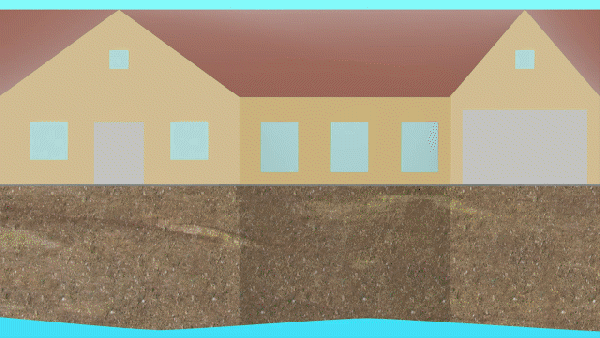
Tools like the EPA’s radon zone map are a great resource for homebuilders, homeowners, and other team members to get a general idea of the areas where potential for indoor radon exposure is highest. However, no level of radon is truly "safe," so local information and testing is key to determining radon risk.
Beyond that, radon-resistant construction techniques built into the design — such as ASD systems and vapor barriers — will significantly decrease the chance of elevated radon concentrations in the home.
When we build these elements into the design and construction process, we help ensure homeowner peace of mind. It’s about getting it right the first time, so homeowners don’t have to live in an unsafe environment for any time, let alone seven years.
** Note: Products that have been tested to ASTM E1745 - 17 Standard Specification for Plastic Water Vapor Retarders Used in Contact with Soil or Granular Fill Under Concrete Slabs will typically provide better longevity than generic plastic products.

Written by Tom Marks
Tom Marks is the Business Development Project Manager with Stego Industries, LLC. He has been with Stego since 2007, serving many years as the Rocky Mountains Regional Manager. Now, his focus is geared toward vapor barrier solutions for new and existing homes as the Product Manager of the StegoHome and StegoCrawl brands. In addition, Tom serves as Sustainability Manager, overseeing Stego’s leadership in holistic product and corporate sustainability. Tom enjoys working with a wide range of project team members and customers to incorporate effective sub-slab vapor protection and create healthy, sustainable homes and buildings.
- Stego (26)
- StegoCrawl (24)
- Stego-Awareness (17)
- Case Studies (14)
- StegoCrawl-Consideration (12)
- StegoCrawl-Awareness (11)
- StegoHome (10)
- Customer Stories (9)
- Stego-Consideration (9)
- Pango (8)
- Beast (7)
- StegoHome-Awareness (6)
- How to Install (5)
- Pango-Awareness (5)
- Beast-Awareness (4)
- Drago (4)
- StegoHome-Consideration (4)
- Beast-Consideration (3)
- Pango-Consideration (3)
- Stego IQ (3)
- Drago-Awareness (2)
- Drago-Consideration (2)
- StegoCrawl-Decision (2)
Popular Posts
Stay Connected.
Enter your email below.



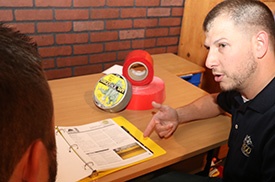
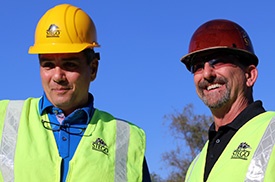
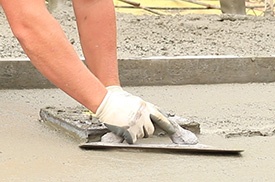





Post Comments